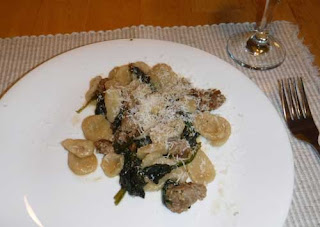We had a string of spring-like weather this week. Patches of
bare ground appeared where the wind had blown the snow away and under the
trees.
 |
| The first glimpse of the grass beneath the snow |
In the middle of supper on Wednesday, I saw a possum in the
orchard. “North America’s only marsupial!” Terry said. He loves possums. The
possum went from tree to tree until it found a withered apple, which it commenced
to eat. I put on my Wellies and grabbed my camera. The snow was deeper than I
thought it would be after days of above-freezing temperatures. My Wellies were
not tall enough to keep the snow out. Amazing that it was still more than a
foot deep. Because it was in the last bit of daylight, I didn’t get a good
picture. The exposure time was too long without the flash, and obviously I can’t
stand still enough for a clear picture. I tried with the flash but the
autofocus decided that I wanted a picture of the deer fence around the orchard
rather than the possum inside it. Bah.
 |
| Bad photo of a possum eating an apple (right). Its little pink toes must be freezing! |
My seed orders arrived along with new sprouting trays. I
ordered the trays so I could grow sprouts for the hens to give them a little
excitement to break up the boredom of winter. I started with the alfalfa seeds
that came with the kit. The rest of the sprouting seeds were ordered from a
cheaper source. The sprouter is ingenious. The trays have ridges, and there are
holes in the outermost ridge. The water drips down through the holes leaving
behind a layer of water the depth of the outer ridge. All I have to do is empty
the catch tray and pour 2 cups of water in the top twice a day.
 |
| Water dripping between the layers |
After four days, the sprouts looked like this.
 |
| 4-day-old alfalfa sprouts |
Now that it’s been a week, they are ready to eat. Whatever
we don’t use will go to the girls.
 |
| 1 week and ready to eat! (Poor innocent sprouts!) |
I know the hens are bored by their scruffy appearance. They
are pecking at each other. The Australorps are the prime suspects, as they look
less scruffy than the rest. The poor Wyandottes, which are supposed to have (as
you may recall) lovely white feathers with black edges, look uniformly gray and
downy on their backs. I can only hope their regular feathers will grow back
once we get them back in the summer pasture.
 |
| Bedraggled Wyandottes |
I took a deep breath and slogged through the drifts to check
on the high tunnel. After two weeks of below-zero temperatures, I had few expectations.
Indeed, there were no survivors in the herb bed. The chives will grow back. As
far as I know, it is impossible to kill chives. The rest will need to be
planted again.
 |
| Not just merely dead, but really most sincerely dead (except the chives, upper right) |
The lettuce may or may not still be alive. The mâche
looks great! The radishes are definitely dead.
 |
| Questionable lettuce, left; apparently alive mache, right; dead radishes in the middle |
And look at the spinach! It remains to be seen if these
apparent survivors will start putting out new leaves.
 |
| Hale and hardy spinach |
In other excitement, we got the onions planted last Friday.
 |
| Four flats for four varieties of onions, planted Feb. 25 |
They are starting to sprout. Note that as the shoot
develops, it raises the seed coat out of the ground. We call this “epigeal” development
in the business.
 |
| Cute little onion sprouts, today. Note black seed coat at the end of the shoot |
Even with all this excitement, I did not forget my sourdough
experiments. This week I made cinnamon-raisin sourdough. It wasn’t clear what
the starter was for. It did not seem to impart any sourness to the final bread,
and there was plenty of yeast for it to rise on that alone. Still, it was a
nice soft loaf and made excellent French toast. I suspect, however, that the result
would be the same if one left the sourdough starter out.
 |
| Cinnamon-raisin sourdough bread |
It was 11° this morning, which took the wind out
of our spring-is-coming sails. The snow will never melt like this! We are hoping
the forecasts for warmer temperatures for the rest of the week come true.










































